Crash of a Grumman TC-4C Gulfstream I at Cherry Point MCAS: 9 killed
Date & Time:
Registration:
155723
Survivors:
No
Schedule:
Cherry Point - Cherry Point
MSN:
178
YOM:
1967
Crew on board:
2
Crew fatalities:
Pax on board:
7
Pax fatalities:
Other fatalities:
Total fatalities:
9
Circumstances:
Shortly after lift off, a low torque sensing switch failed precipitating an auto feather of an engine. The crew mis-handled the required feathering procedure, allowing the propeller to unfeather and windmill. Subsequently, the crew retracted the flaps. This disabled a spring tab on the rudder which was designed to give additional rudder authority for high power/low airspeed situations. The result of the windmilling propeller and the loss in rudder authority was that V(mca) increased from 101 kts to 138 kts. The airplane rolled inverted and crashed. Witness marks on the operating engine's propeller reportedly indicated that the airplane's speed when it crashed was less than 90 kts. All on board, four crew men, four students and one instructor, were killed.







